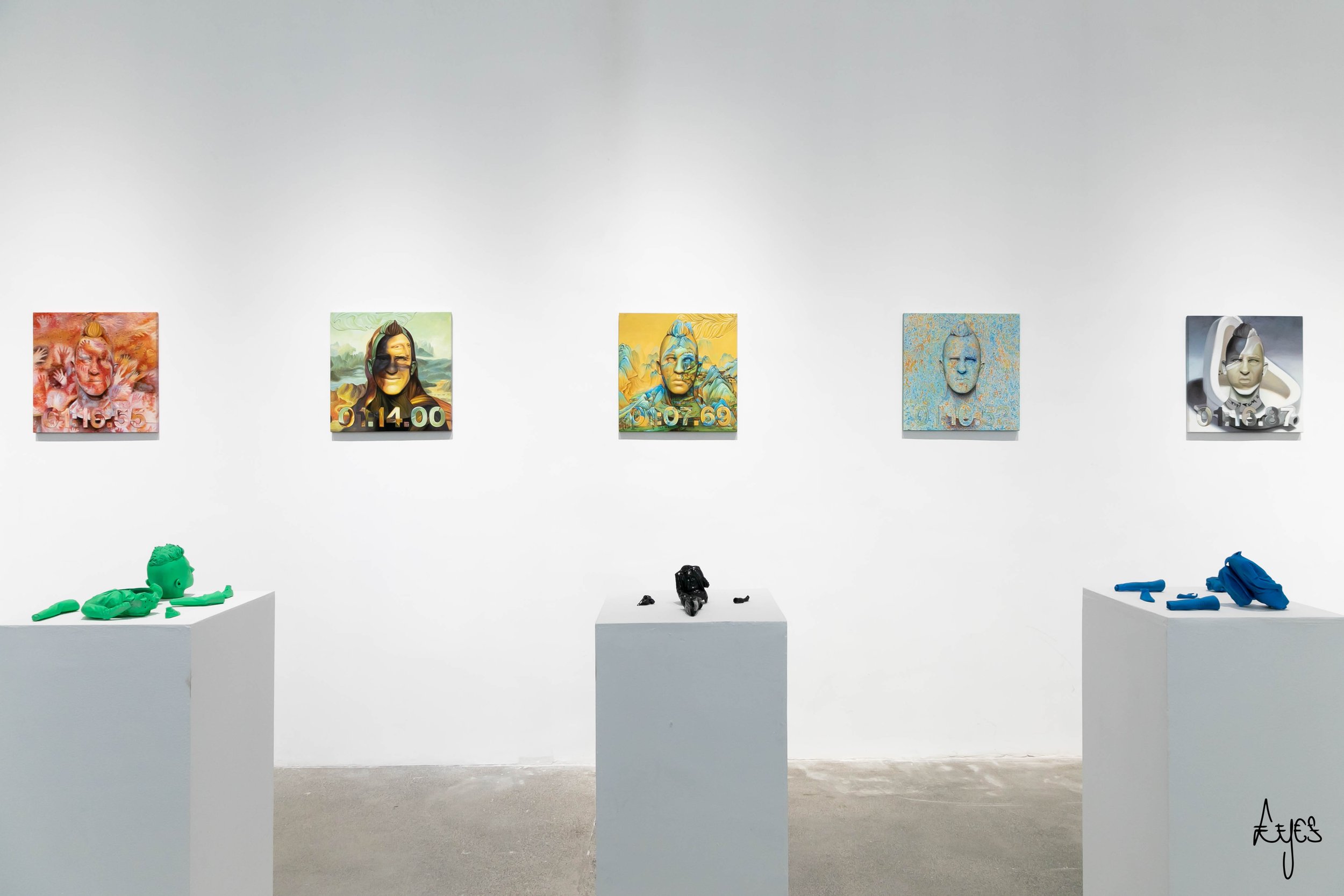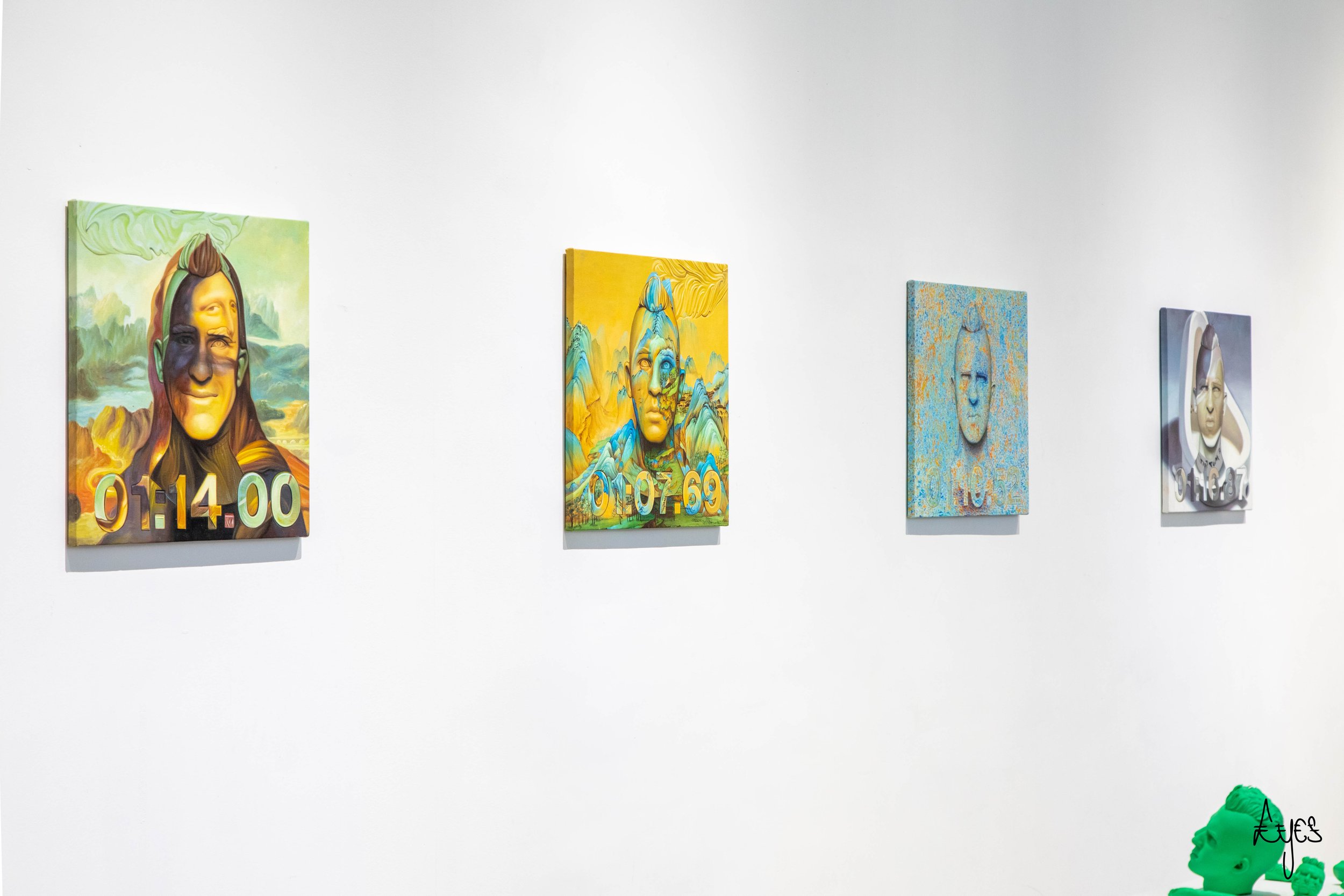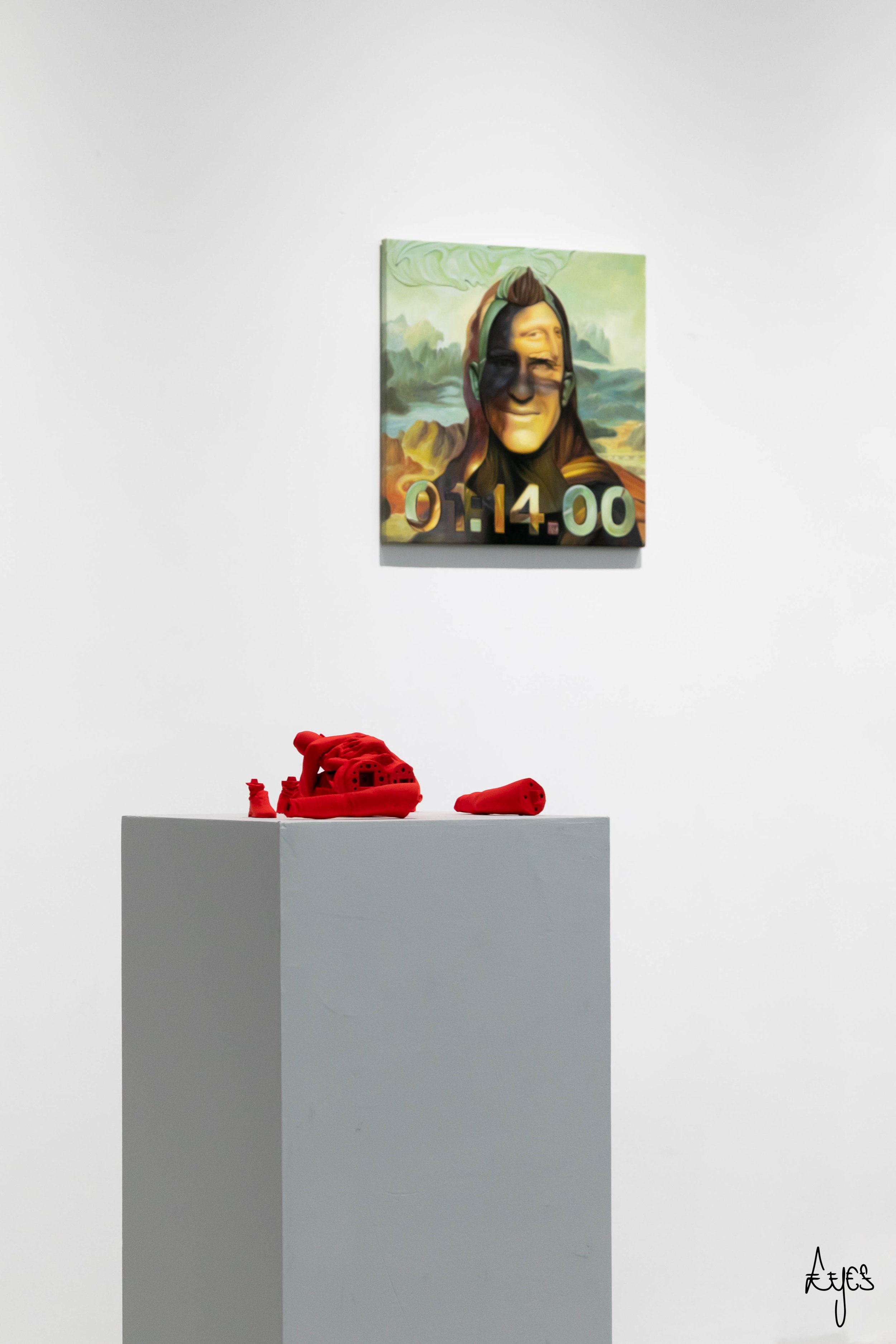
Ego Spectrum 自我频谱
2022, 400x400x20mm, Oil paint on linen canvas.
The series of 7 “self-portraits” is named Ego spectrum because it was inspired by the science of communication ethology which identified 7 emotions universally shared by cultures around the world. These are the 7 emotions that universally allow humans to communicate outside of the cultural boundaries.
The paintings are made of the association of the artist’s face expressing one of the universal emotion amongst anger, surprise, fear, sadness, contempt, disgust and happiness . Second observation would show that a work of art is plated onto the face of the artist and the background of the painting. The background of the painting is made from the unfolded face of the artist as if itwas peeled off and layed on a flat square. Each of the paintings has a significance that is a milestone in the history of painting in a broad cultural spectrum.
The greatest event that transformed the history of modern and contemporary art was the invention of photography: before it, artists had a function of representing the world that was linked to their technical skills. Only a few wealthy people could afford paintings and portraits of their family members. Portraits were then indicators of social status. After the invention of photography, artists were deprived of their exclusive ability to represent the world, so they became the interpreters of the world through their art and thus was born the artist style. The artists then presented an exclusive vision that they had of the world. This vision carries a message either sensitive or analytical of the world which was intended as subjective, because perceived by the critical eyes of the artist.
The arrival of cameras and artificial intelligence exacerbates today the idea that in matters of creation technique is nothing but a tool that is always preceaded by idea. Recently, the artificial “intelligence” DALL E and IMAGEN are technologies that allow anyone to become an artist, just by writing down a text sentence that the computer will translate into an image, and moreover, it can display the style of other artists whose aesthetic are recognizable. The artist ego was a necessary step in the process of history of art evolution that is now fading away. Art and creativity are becoming more universal and does not seclude to the technical abilities of a few that have the ability to create art. Nor to a happy few that had the codes to decypher artworks.
From the observation of these developments was born the series of 7 self-portraits. On the lower part of the paintings, the numbers that are indicated are time codes, in minutes, seconds and microseconds:
Before being paintings these images were 3D sculptures whose rendering has been calculated by a computer. The numbers at the bottom of the image are the record of this time that was included in the image during its calculation. In other words, these numbers are the approximate precalculation of the time needed to render them. This figure can only be an approximation since the final rendering time will affect the numbers included in the image and again will affect the calculation time. This loop between the estimated time and the necessary time to calculate the rendering time of an image compared to the actual time needed for the render underlines that we are closer and closer to the notion of “real-time” in our ability to simulate a virtual reality . The allusion to time is also a tribute to the work of the painter On Kawara, aswell as it anchors it’s reflexion to the continuity of John Baldessari’s work ‘s series called “ poiting at things “.
Time spent on the realisation of an artwork and technical qualities are not relevant in our current era where technology’s artificial intelligence is “learning” faster than human can. This emphasizes the primacy of the idea over the style or quality of execution, wich is the primacy of thought.
The Ego Spectrum portrait series was painted by anonymous technically skilled painters whose service was requested on Taoabao online platform. The technique is sufficient to express the idea of the artist, the late one beeing original or derived from the works of On Kawara and John Baldessari, that is for the spectator to tell.
For the artist: his image is the easiest one to study, it remains his best study model, as can be for a Buddhist monk the chaos of his uncontrolled thoughts stream when he learns to meditate. This work brings up the relationship that our societies have with the selfie and the notion of authenticity. If in China the selfie is not badly perceived, it is in Western societies that value the notion of authenticity. For means of authenticity ,a selfie taken in the West may feign spontaneity in the pause. The 7 portraits make the rigorous and systematic choice to present the entire spectrum of emotions universally recognized, the artist does not highlight himself, he rather drapes himself in the legitimacy that gives him the citation of the works in which they are presented: Each of the paintings presents an emotion that is understood at first glance of the borrowed work used in background. The toilet of Duchamps evokes disgust, Mauricio Cattelan’s banana evokes surprise, the handprints in the neolithic caves evoke satisfaction, etc.
La série de 7 “autoportraits” s’appelle Ego Spectrum car elle a été inspirée par la science de l’éthologie de la communication qui a identifié 7 émotions universellement partagées par les cultures du monde entier. Ce sont les 7 émotions qui permettent universellement aux humains de communiquer en dehors des frontières culturelles. Les peintures sont faites de l’association du visage de l’artiste exprimant l’une des émotions universelles parmi la colère, la surprise, la peur, la tristesse, le mépris, le dégoût et le bonheur. Une deuxième observation montrerait qu’une œuvre d’art est plaquée sur le visage de l’artiste et le fond de la peinture. Le fond de la peinture est fait du visage déplié de l’artiste comme s’il avait été pelé et posé sur un carré plat. Chacune des peintures a une signification qui est une étape importante dans l’histoire de la peinture dans un large spectre culturel.
L’arrivée des caméras et de l’intelligence artificielle exacerbe aujourd’hui l’idée que, en matière de création, la technique n’est rien d’autre qu’un outil qui est toujours précédé par l’idée. Récemment, les technologies d’intelligence artificielle DALL E et IMAGEN permettent à n’importe qui de devenir artiste, simplement en écrivant une phrase de texte que l’ordinateur traduira en image, et en affichant en plus le style d’autres artistes dont l’esthétique est reconnaissable. L’ego de l’artiste était une étape nécessaire dans le processus d’évolution de l’histoire de l’art qui s’estompe maintenant. L’art et la créativité deviennent de plus en plus universels et ne se limitent pas aux capacités techniques de quelques personnes capables de créer de l’art.
La série de portraits Ego Spectrum a été peinte par des peintres anonymes techniquement doués dont les services ont été demandés sur la plateforme en ligne Taoabao. La technique est suffisante pour exprimer l’idée de l’artiste, que celle-ci soit originale ou dérivée des œuvres d’On Kawara et de John Baldessari, c’est au spectateur de le dire.
Pour l’artiste : son image est la plus facile à étudier, elle reste son meilleur modèle d’étude, comme peut l’être pour un moine bouddhiste le chaos de son flux de pensées incontrôlées lorsqu’il apprend à méditer. Cette œuvre soulève la relation que nos sociétés ont avec le selfie et la notion d’authenticité. Si en Chine le selfie n’est pas mal perçu, c’est dans les sociétés occidentales que l’on valorise la notion d’authenticité. Pour des raisons d’authenticité, un selfie pris en Occident peut feindre la spontanéité de la pause. Les 7 portraits font le choix rigoureux et systématique de présenter l’ensemble du spectre d’émotions universellement reconnues, l’artiste ne se met pas en avant, il s’enveloppe plutôt de la légitimité que lui confère la citation des œuvres dans lesquelles ils sont présentés : chaque tableau présente une émotion qui est comprise d’un seul coup d’œil à partir de l’œuvre empruntée utilisée en arrière-plan. La toilette de Duchamp évoque le dégoût, la banane de Mauricio Cattelan évoque la surprise, les empreintes de main dans les grottes néolithiques évoquent la satisfaction, etc.
这个由7幅 “自画像 “组成的系列被命名为 “自我光谱”,因为它的灵感来自于沟通伦理学,它确定了全世界文化普遍共享的7种情绪。这7种情绪普遍允许人类在文化边界之外进行交流。
这些画是由艺术家的脸部联想而成的,是一种情绪的表达。它们也简明扼要地说明了艺术家脸上的艺术作品的镀层和绘画的背景。绘画的背景是由艺术家展开的脸做成的,就像它的脸被剥掉了一样。 每一幅画都有其意义,在广泛的文化范围内,它是绘画史上的一个里程碑。
改变现代和当代艺术历史的最大事件是摄影术的发明:在这之前,艺术家有一个表现世界的功能,这与他们的技术能力有关。只有少数富人能买得起绘画和他们家庭成员的肖像画。那时,肖像画是社会地位的指标。摄影术发明后,艺术家们被剥夺了表现世界的独家能力,所以他们通过艺术成为世界的诠释者,艺术家风格由此诞生。然后,艺术家们提出了他们对世界的独家看法。这种视野带着对世界的敏感或分析的信息,其目的是主观的,因为被艺术家的批判的眼睛所感知。
今天,照相机和人工智能的到来加剧了这样一种想法:在创造的问题上,技术只不过是一种手段,而想法是先入为主的。最近,DALL E和IMAGEN的应用是允许任何人成为艺术家的技术,只需写下一个文本句子,计算机将翻译成图像,此外,它可以显示其他艺术家的风格,其审美是可识别的。艺术的自我是艺术演变历史过程中的一个必要步骤,现在正在逐渐消失。艺术和创造力正变得越来越普遍,并不局限于少数有能力创造艺术的人的技术能力。也不局限于少数拥有破译艺术作品密码的快乐的人。
从对这些发展的观察中,诞生了7幅自画像系列。在画的下部,显示的数字是一个时间代码,单位是分、秒和微秒。在成为绘画之前,这些图像是三维雕塑,其渲染是由计算机计算出来的。图像底部的数字是在计算过程中包含在图像中的这个时间的记录。换句话说,这些数字是对渲染所需时间的大致预计算。这个数字只能是一个近似值,因为最终的渲染时间会影响图像中包含的数字,也会影响计算时间。 这种估计时间和计算图像渲染时间的必要时间与实际所需时间之间的循环强调了我们在模拟虚拟现实的能力方面越来越接近于 “实时 “的概念。 对时间的影射也是对画家On Kawara的作品的致敬,并将其与John Baldessari的作品 “poiting at things “系列的连续性联系起来。
在我们这个技术的人工智能比人类更快地 “学习 “的时代,花在实现艺术作品和技术质量上的时间并不重要。 这强调了想法的首要地位,而不是执行的风格或质量,这是思想的首要地位。 自我光谱 “肖像系列是由匿名人士创作的,他们的服务是在淘宝网平台上要求的。该技术足以表达艺术家的想法,这是原创。
如果乍一看,呈现7幅自画像似乎很自恋,那么,记住以下几点是很有意义的:对艺术家来说:他的形象是最容易研究的,它仍然是他最好的研究模型,就像对一个佛教徒来说,当他学会打坐时,他的思想的混乱也可以是这样。这件作品质疑我们社会与自拍和真实性概念的关系。如果说在中国,自拍没有被看扁,那就是在重视真实性概念的西方社会。相反,在西方拍摄的自拍可能会在停顿中佯装自发。这7幅肖像画做出了严格和系统的选择,呈现了普遍认可的整个情感谱系,艺术家没有突出自己,而是将自己披上了合法的外衣,使其在作品中被引用。 每幅画都呈现了一种情感,在第一眼看到用于背景的借来的作品时就能理解。 杜尚的厕所引起了厌恶,毛里西奥-卡泰兰的香蕉引起了惊讶






